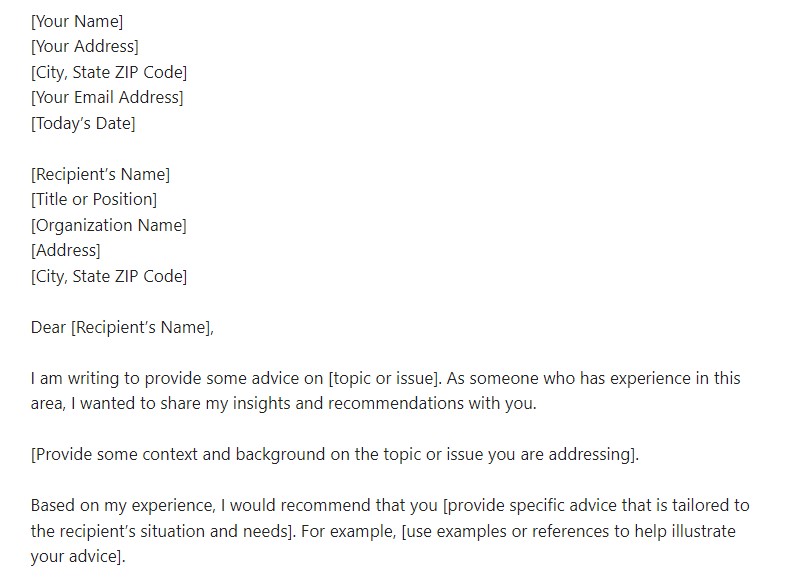Advice letters are written to provide guidance, suggestions, or recommendations to someone seeking advice on a particular topic. Writing an effective advice letter can be helpful in building and maintaining relationships, both personal and professional. Here’s a guide to help you write an effective advice letter that provides valuable guidance and helps the recipient make informed decisions. This guide includes tips and examples for giving advice in writing.
Here are some frequently asked questions about advice letters:
What is an advice letter?
An advice letter is a type of correspondence that provides guidance, recommendations, or suggestions to the recipient. It is usually written in response to a specific request for advice or as a proactive measure to provide guidance in a particular area.
Who may need an advice letter?
Anyone who is seeking guidance, recommendations, or suggestions on a particular topic or issue may need an advice letter. This could include individuals seeking personal or career advice, organizations seeking guidance on a particular policy or strategy, or students seeking academic or professional guidance.
What should be included in an advice letter?
An advice letter should provide clear, concise, and actionable guidance on the topic or issue at hand. It should be well-organized, with a clear introduction, body, and conclusion. The advice should be tailored to the recipient’s specific situation and needs, and any relevant examples or references should be provided.
How should an advice letter be written?
An advice letter should be written in a friendly and helpful tone, with a focus on providing actionable guidance that is specific to the recipient’s needs. It should be clear, concise, and free of jargon or technical language that may be confusing to the recipient.
What is the format for an advice letter?
The format for an advice letter may vary depending on the purpose and audience, but it should generally include a clear introduction that states the purpose of the letter, a well-organized body that provides guidance and recommendations, and a conclusion that summarizes the main points and provides any necessary follow-up information.
Can an advice letter be sent via email?
Yes, an advice letter can be sent via email. However, it is important to ensure that the message is clear, concise, and professional, and that any attachments or references are included as necessary.
Is it necessary to follow up after sending an advice letter?
It may be a good idea to follow up after sending an advice letter, especially if the recipient requested the advice or if the advice was related to a particular project or initiative. This can help ensure that the recipient has understood and acted on the advice, and can also help build a stronger relationship between the parties involved.
Here are some steps to help you write an effective advice letter:
1. Begin with a professional greeting:
Start your letter with a professional greeting, such as “Dear [Recipient’s Name]” or “To Whom It May Concern.” Use the appropriate title or salutation to address the recipient.
2. Introduce yourself and the purpose of the letter:
Introduce yourself briefly and state the purpose of the letter. This can be as simple as saying, “I am writing to provide some advice on [topic or issue].”
3. Provide context and background:
Provide some context and background on the topic or issue you are addressing. This can help the recipient understand the situation better and tailor your advice to their specific needs.
4. Provide specific advice:
Provide specific advice that is tailored to the recipient’s situation and needs. Be clear, concise, and actionable in your recommendations, and provide any necessary details or explanations.
5. Use examples or references:
Use examples or references to help illustrate your advice and make it more concrete. This can help the recipient understand how to apply your advice in their specific situation.
6. Close the letter with a summary and next steps:
Close the letter with a summary of your advice and any next steps that the recipient should take. This can help the recipient understand what they need to do to act on your advice.
7. End with a professional closing:
End the letter with a professional closing, such as “Sincerely” or “Best regards,” followed by your name and contact information.
Here’s an example of an advice letter:
[Your Name]
[Your Address]
[City, State ZIP Code]
[Your Email Address]
[Today’s Date]
[Recipient’s Name]
[Title or Position]
[Organization Name]
[Address]
[City, State ZIP Code]
Dear [Recipient’s Name],
I am writing to provide some advice on [topic or issue]. As someone who has experience in this area, I wanted to share my insights and recommendations with you.
[Provide some context and background on the topic or issue you are addressing].
Based on my experience, I would recommend that you [provide specific advice that is tailored to the recipient’s situation and needs]. For example, [use examples or references to help illustrate your advice].
It’s important to remember that [provide any necessary details or explanations]. By following these recommendations, you can [explain the benefits or outcomes of following your advice].
If you have any questions or concerns, please do not hesitate to contact me. I’m happy to discuss this further with you.
Sincerely,
[Your Name]
[Your Contact Information]
